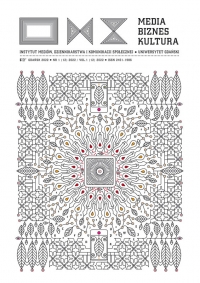Zdrowie na sprzedaż? Telewizyjne reklamy farmaceutyków a peryferyjna droga perswazji
Słowa kluczowe:
komunikowanie zdrowotne, reklama telewizyjna, perswazja, farmaceutyki, Elaboration Likelihood ModelAbstrakt
W artykule przedstawiono wyniki analizy zawartości telewizyjnych reklam farmaceutyków w kontekście peryferyjnej drogi perswazji. Badania przeprowadzono na podstawie 4052 spotów wyemitowanych w trzech ogólnopolskich stacjach telewizyjnych w listopadzie 2020 roku i styczniu 2021 roku. Na podstawie uzyskanych wyników wykazano, że w przeważającym stopniu reklamy związane z tą grupą produktów nie opierają się na odwołaniach do medycyny. Autorzy tych przekazów rzadko wykorzystują obraz przedstawicieli zawodów medycznych jako ekspertów. Na podstawie przeprowadzonych analiz nie stwierdzono również kreowania narracji z wykorzystaniem takich narzędzi perswazji jak sceny nawiązujące do środowiska medycznego oraz specjalistyczne słownictwo. Zebrany materiał badawczy wykazał, że rolę autorytetu w reklamach leków OTC, suplementów diety oraz wyrobów medycznych bardzo często spełniają członkowie rodziny i przyjaciele. Najczęściej wykorzystywanym rodzajem scen są przestrzenie nawiązujące do życia codziennego. Na podstawie przeprowadzonego badania wskazano na nowe trendy zaobserwowane w telewizyjnych reklamach farmaceutyków, które wynikają zarówno z uwarunkowań prawnych, jak i pogłębiającej się mediatyzacji w obszarze medycyny.
Downloads
Bibliografia
Bohner G., Moskowitz G.B., Chaiken S., The interplay of heuristic and systematic processing of social information, „European Review of Social Psychology” 1995, No. 6, s. 33–68.
Brock T.C., Green M.C., Perswazja. Perspektywa psychologiczna, przeł. T. Sieczkowski, M. Kowaleczko-Szumowska, Wydawnictwo Uniwersytetu Jagiellońskiego, Kraków 2007.
CBOS, Wartości w czasach zarazy, https://www.cbos.pl/SPISKOM.POL/2020/K_160_20.PDF (dostęp: 20.09.2021).
CBOS, Zaufanie społeczne, https://www.cbos.pl/SPISKOM.POL/2020/K_043_20.PDF (dostęp: 30.10.2021).
Cialdini R., Wywieranie wpływu na ludzi. Teoria i praktyka, przeł. B. Wojciszke, Gdańskie Wydawnictwo Psychologiczne, Gdańsk 1998.
Doliński D., Psychologiczne mechanizmy reklamy, Gdańskie Wydawnictwo Psychologiczne, Gdańsk 2005.
Fuyuan S., Vivian S.C., Ruobing L., Impact of narratives on persuasion in health communication: A meta-analysis, „Journal of Advertising” 2015, No. 44, 105–113.
Goban-Klas T., Od doktora House›a do doktora Google. Jak nowe media, Internet i smartfony zmieniają opiekę zdrowotną, „Komunikacja Społeczna. Czasopismo elektroniczne” 2013, nr 3(7), s. 3.
Haławin A., Konstrukcja komunikacji w reklamach leków i suplementów diety, „Dziennikarstwo i Media” 2018, nr 9, s. 99.
Jach Ł., Chmiel S., Polecam! – naukowiec / „Polecam” – konsument. Znaczenie obecności i społecznych lub naukowych dowodów słuszności dla oceny wiarygodności reklam w kontekście refleksyjności poznawczej, maksymalizacji i światopoglądu scjentystycznego, „Psychologia i Społeczeństwo” 2018, nr 13, s. 31.
Komar S., The effects of verbal and non-verbal features on the reception of DRTV commercials, „ELOPE: English Language Overseas Perspectives and Enquiries” 2016, No. 2, s. 191–192.
Kraszkiewicz D., Waniowski P., Postrzeganie reklamy telewizyjnej produktów farmaceutycznych w świetle wyników badań bezpośrednich, „Ekonomia – Wroclaw Economic Review” 2020, nr 4, s. 15.
Krippendorff K., Content analysis: An introduction to its methodology. Second edition, Sage Publications, Thousand Oaks, CA 2004.
Michalczyk S., Jednostka i społeczeństwo w świecie mediów: klasyczne i współczesne idee w teoriach średniego zasięgu, Wydawnictwo Naukowe „Śląsk”, Katowice 2015.
Mroczek B., Witsanko A., Grochans E., Rotter I., Jasińska M., Jurczak A., Żułtak-Bączkowska K., Wpływ reklamy na zakup leków bez recepty przez osoby powyżej 60. roku życia, „Family Medicine & Primary Care Review” 2012, No. 3, s. 408.
Olszanecka-Marmola A., Techniki perswazyjne w telewizyjnych reklamach sieci sklepów spożywczych, firm telekomunikacyjnych oraz banków w początkowej fazie pandemii COVID-19, „Zarządzanie Mediami” 2021, nr 2, s. 374.
Petty R.E., Cacioppo J.T., The elaboration likelihood model of persuasion, „Advances in Experimental Social Psychology” 1986, No. 19, s. 123–205.
Pisarek W., Analiza zawartości prasy, Ośrodek Badań Prasoznawczych RSW „Prasa – Książka – Ruch”, Kraków 1983.
Szwed B., Multimodalność w audiowizualnych reklamach produktów farmaceutycznych, „Media – Kultura – Komunikacja Społeczna” 2020, nr 3(15), s. 72.
Ustawa z dnia 6 września 2001 roku Prawo farmaceutyczne (Dz. U. z 2016 r., poz. 12142 z późn. zm.).

 Uniwersyteckie Czasopisma Naukowe
Uniwersyteckie Czasopisma Naukowe




